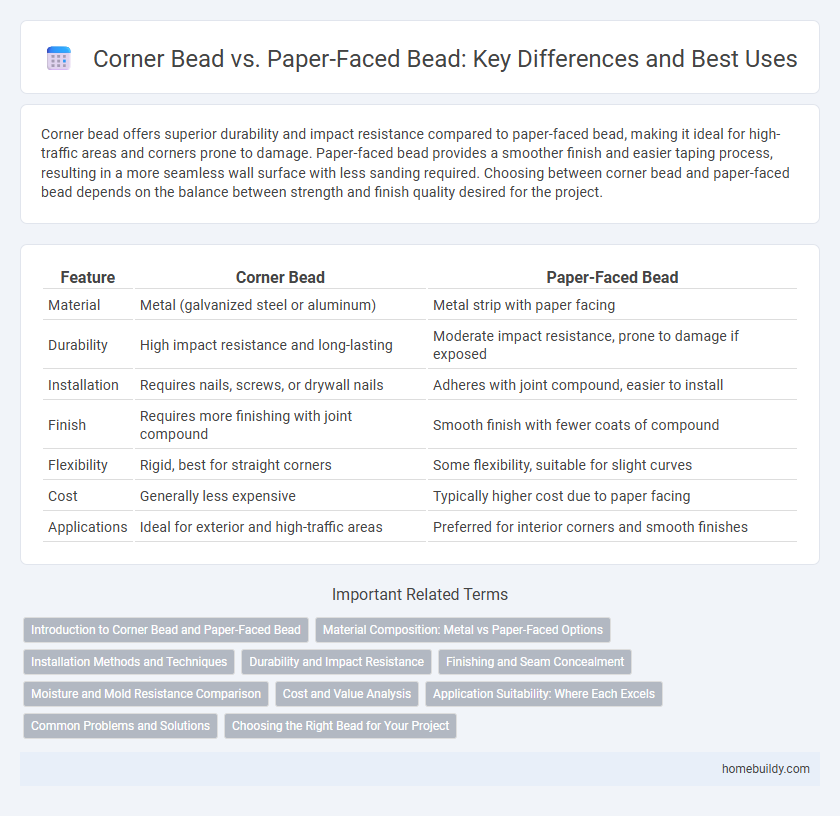Corner bead offers superior durability and impact resistance compared to paper-faced bead, making it ideal for high-traffic areas and corners prone to damage. Paper-faced bead provides a smoother finish and easier taping process, resulting in a more seamless wall surface with less sanding required. Choosing between corner bead and paper-faced bead depends on the balance between strength and finish quality desired for the project.
Table of Comparison
| Feature | Corner Bead | Paper-Faced Bead |
|---|---|---|
| Material | Metal (galvanized steel or aluminum) | Metal strip with paper facing |
| Durability | High impact resistance and long-lasting | Moderate impact resistance, prone to damage if exposed |
| Installation | Requires nails, screws, or drywall nails | Adheres with joint compound, easier to install |
| Finish | Requires more finishing with joint compound | Smooth finish with fewer coats of compound |
| Flexibility | Rigid, best for straight corners | Some flexibility, suitable for slight curves |
| Cost | Generally less expensive | Typically higher cost due to paper facing |
| Applications | Ideal for exterior and high-traffic areas | Preferred for interior corners and smooth finishes |
Introduction to Corner Bead and Paper-Faced Bead
Corner bead is a metal or plastic strip used to reinforce and create sharp corners in drywall installations, providing durability and a clean finish. Paper-faced bead combines a metal or vinyl corner bead with a paper tape flange that helps reduce cracking and simplifies the drywall finishing process. This combination enhances adhesion and creates a smoother, more seamless corner compared to traditional metal corner beads.
Material Composition: Metal vs Paper-Faced Options
Metal corner bead is typically made from galvanized steel or aluminum, providing superior durability and resistance to impact compared to paper-faced bead, which is composed of a rigid metal or plastic core wrapped in a paper surface for easier mud adhesion. The galvanized steel material in metal corner beads offers excellent corrosion resistance and long-lasting structural integrity, whereas paper-faced beads combine flexibility with smooth finishing but may be less durable in high-traffic areas. Choosing between metal and paper-faced corner beads depends on the balance needed between robustness and ease of finishing, with metal favored for strength and paper-faced preferred for seamless drywall joint finishes.
Installation Methods and Techniques
Corner bead installation involves fastening metal or vinyl strips to drywall corners using screws, nails, or adhesive to create a durable edge. Paper-faced bead requires embedding the paper flange into joint compound with a taping knife, ensuring a smooth finish and reducing the risk of cracking. Techniques for paper-faced bead emphasize thorough mud application and feathering for seamless blending, while metal corner bead demands precise alignment and securing to prevent movement during finishing.
Durability and Impact Resistance
Corner bead made from metal or vinyl offers superior durability and impact resistance compared to paper-faced bead, which is prone to tearing and water damage. Metal corner beads provide a rigid and long-lasting edge protection, ideal for high-traffic areas, while vinyl corner beads resist dents and corrosion. Paper-faced beads, although easier to install and finish smoothly, lack the robustness required for environments subject to frequent impacts or moisture.
Finishing and Seam Concealment
Corner bead offers superior durability and crisp edge definition, ensuring a clean finish on drywall corners. Paper-faced bead excels in seam concealment by blending seamlessly into joint compound, reducing taping and sanding effort. Choosing between the two depends on prioritizing either edge protection or a smoother, more concealed finish.
Moisture and Mold Resistance Comparison
Corner bead made from metal or vinyl offers superior moisture resistance compared to paper-faced bead, which is susceptible to water damage and mold growth. Paper-faced bead combines metal or plastic with a paper flange that can absorb moisture, increasing the risk of mold in damp environments. Vinyl and metal corner beads are preferred in high-humidity areas due to their non-porous surfaces that inhibit mold development and maintain structural integrity.
Cost and Value Analysis
Corner bead typically offers a lower upfront cost compared to paper-faced bead, making it a budget-friendly choice for drywall projects. Paper-faced bead tends to have higher durability and resistance to cracking, which can translate to long-term value by reducing maintenance and repair expenses. Evaluating the balance between initial investment and lifespan performance is crucial when selecting the most cost-effective corner reinforcement solution.
Application Suitability: Where Each Excels
Corner bead excels in high-impact areas such as exterior corners and drywall edges due to its sturdy metal or vinyl composition, providing maximum protection against chipping and cracking. Paper-faced bead is ideal for smooth, curved corners and interior walls where a seamless finish and easy paintability are priorities, as its paper surface integrates well with joint compound. Each type is chosen based on the specific application requirements, with corner bead favored for durability and paper-faced bead preferred for aesthetic refinement.
Common Problems and Solutions
Corner bead often faces issues such as cracking, chipping, and improper adhesion, leading to weak corners and visible damage over time. Paper-faced bead addresses these problems by providing enhanced flexibility, better adhesion, and resistance to cracking due to its reinforced paper surface, which bonds more effectively with joint compound. Proper installation techniques and using paper-faced bead in high-traffic areas reduce frequent repairs and maintain durable, clean corners.
Choosing the Right Bead for Your Project
Choosing between corner bead and paper-faced bead depends on the specific needs of your drywall project, as corner bead offers rigid metal or vinyl reinforcement for durable, sharp corners, while paper-faced bead provides a smoother, more seamless finish ideal for curved or irregular corners. Metal corner beads are highly resistant to impact, making them suitable for high-traffic areas, whereas paper-faced beads are easier to install and reduce the risk of cracking due to their flexible paper flange. Selecting the right bead involves considering factors like corner shape, desired durability, and finishing texture to ensure optimal structural integrity and aesthetic appeal.
corner bead vs paper-faced bead Infographic

 homebuildy.com
homebuildy.com